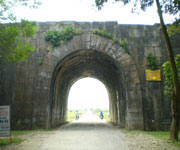The Ho Citadel is an Outstanding Example
The property exhibits Chinese Confucianism influence on a symbol of regal centralized power in the late 14th – early 15th century. It represents new developments in architectural style with respect to technology and, in adapting pre-existing geomantic city planning principles in an East Asian and South-east Asian context, makes full use of the natural surroundings and incorporated distinctly Vietnamese and East and Southeast Asian elements in its monuments and landscape.
The Ho Citadel is an outstanding example of an architectural ensemble in a landscape setting which illustrates a flowering of pragmatic Neo-Confucianism in late 14th century Viet Nam, at a time when it was spreading throughout East Asia to become a major philosophical influence on government in the region. The use of large blocks of stone testifies to the organizational power of the Neo-Confucian state, and the shift in the main axis distinguishes the Citadel layout from the Chinese norm.
The integrity of the property is guaranteed by the areas of the three major components which represent the characteristics of the Ho Dynasty: the Inner Citadel, the Nam Giao altar and part of La Thanh Outer Wall. These elements reflect the presence of a citadel that has remained almost intact, with massive stone walls within a landscape setting that is easily recognizable. Excavations have also demonstrated a rich source of archaeological evidence preserved underground below the present rice and other crops within the boundaries of the three components.
The buffer zone includes all cultural elements that were part of a large imperial city during the late 14th – early 15th century, including religious monuments, traditional villages, common houses, ancient roads, markets, landing places and scenic beauty spots, which are a direct tangible expression of the cultural values of the property.
The conditions of authenticity in terms of the geo-cultural location and landscape setting of the property are almost unchanged; the layout and architectural design and materials of the Inner Citadel's walls, four gates, sections of moat, and section of La Thanh Outer Wall and archaeological remains of Nam Giao Altar are well preserved. The archaeological excavations in the property reveal well-preserved structures contemporaneous with the Ho Dynasty.
The Inner Citadel and Nam Giao Altar were designated in 1962 as national heritage by Decision of the Ministry of Culture of the Democratic Republic of Vietnam and are protected under the Law on Cultural Heritage of 29/06/2001. The nominated section of La Thanh Outer Wall is in the process of being similarly protected.
The buffer zone is protected by the Law on Environmental Protection of the Socialist Republic of Vietnam, number 52/2005/QH11, Chapter 4, Article 31 of 2005. The property is directly managed by the People's Committees of the relevant communes for the particular component sites, under the Management Board of the Citadel of the Ho Dynasty established by Decision 2264/QD-UBND (30 July 2007).
A comprehensive five–year Management Plan for the property was submitted in November 2010. The control of urban development near the Inner Citadel, in Vinh Loc town particularly along the axis between the Inner Citadel and Mount Don Son, and in the buffer zone generally should receive specific attention so as to protect all view lines along the axes between topographical features, and views within the area enclosed by the line of the outer wall and the Ma and Buoi rivers.
Special attention is needed for the development of a risk-preparedness and management strategy and a strategy for involving local people in the protection and management of the property. The local authority and people are working closely for the preservation and protection of the property through a training and public-awareness raising programme.
Browse All UNESCO World Heritage Sites in
Vietnam. The original UNESCO inscription
Here!!!










No comments:
Post a Comment